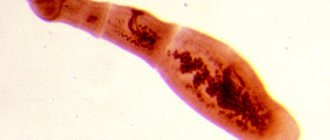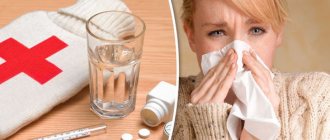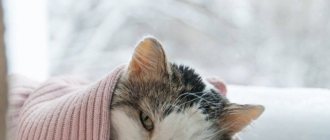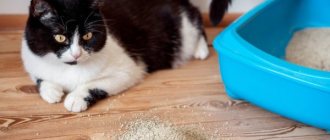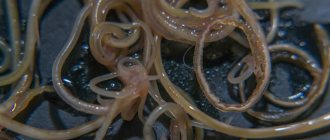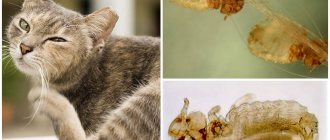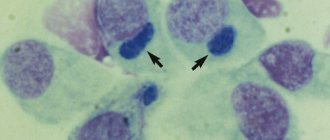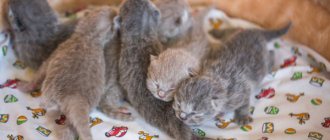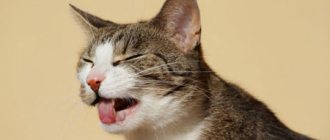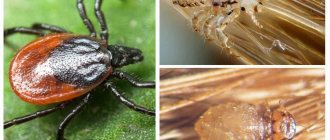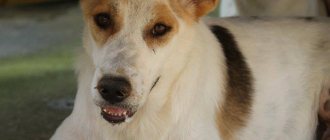Fungi of the genus Microsporum and Trichophyton are dangerous for everyone and, once on the skin, they begin to multiply very quickly. This, of course, is not fatal, but it is very unpleasant and will take a long time to be treated. Moreover, you don’t even have to touch a sick cat or person, as the spores can spread to a new owner. Such a fungal “gift” from a sick animal is called microsporia, and from a person - trichophytosis.
Is lichen transmitted from cats to humans?
How is ringworm transmitted from cat to person?
Most often, they become infected if they take the cat in their arms to cuddle and stroke it. However, not always, sometimes it’s enough to be next to such a cat. People with weak immune systems are at greatest risk, especially children, especially between four and fifteen years of age.
In this sense, petting stray cats is especially dangerous. Even if they don't show the telltale signs of ringworm, they may (and most likely do) have fungal spores on their fur.
Ringworm
Types and symptoms of lichen
Fungal infections on the skin can manifest themselves in different ways, for example, as:
- pityriasis rosea. First, one large plaque appears, around which a scattering of smaller spots appears. The disease appears as if out of nowhere and passes just as quickly;
- ringworm. Due to the activity of the fungus, the hair in the affected area breaks and falls out, and where it remains, it looks as if it has been cut off;
- lichen planus - the skin is dotted with a scattering of small nodules with liquid inside. It lingers in the body for a long time, taking a chronic course and eventually affecting the mucous membranes;
- pityriasis versicolor - a pink rash appears all over the body.
Pityriasis rosea in a child
The fur of a sick animal is a real Klondike: pathogenic spores are present there in huge quantities and infection upon contact with such an animal is almost guaranteed. Especially if the hand with which the unlucky person decided to pet the cat has wounds, microcracks, and scratches.
Ringworm and its transmission from cats
The time from infection to the manifestation of the clinical picture of the disease is called the incubation period. In lichen, it differs depending on the type:
- Pink. The incubation period can last from 2 to 21 days. The first sign is a bright pink oval spot with a diameter of 2-5 cm.
- Encircling. In this form of lichen, the incubation period varies from several days to 4 weeks. The first symptoms are fever, burning and itching of the skin in places where pink spots form.
- Shearer. If a person becomes infected from another person, the incubation period lasts 2-6 weeks. When pathology passes from an animal, it is only 5-7 days.
- Pityriasis. The first signs of this form of the disease may appear 2-3 weeks after infection. Yellow, brown or pink spots appear on the body. In this case, no special sensations arise.
For many, a seemingly harmless disease like chickenpox leaves an unpleasant impression. In most cases, the disease strikes in childhood. The virus that causes chickenpox, even after the baby has fully recovered, does not disappear, but remains in the body for the rest of his life. If a child, then an adult, has everything in order with the immune system, this virus does not show its presence.
Infection period
The incubation period for shingles can last from several days to 4 weeks.
- During the development of the disease, the child’s body temperature rises, he is worried about itching, burning, tingling of the skin in places where pink spots form, the diameter of which is about 5 cm.
- On the second day, vesicles with serous contents inside form in the places where the spots appear. They are usually arranged linearly.
- After several days (8-10), these bubbles begin to burst and dry out, and crusts form in their place.
Often during this period, children experience enlarged lymph nodes and catarrhal symptoms.
Shingles is very rare in children under 10 years of age; in most cases, it affects older people. Skin rashes appear within the first 2-3 days; after 3-4 weeks, the disease subsides, leaving behind a strong immunity against the pathogen. Treatment is prescribed by the doctor after examining the sick child and determining the severity of the disease.
Pityriasis rosea
| Type of lichen | Incubation period |
| Ringworm | The incubation period ranges from 4-5 days when infected from an animal. When infected from humans, the period is up to 2 weeks. |
| Shingles | The incubation period in humans ranges from 3 days to one month. |
| Pityriasis rosea | The incubation period lasts for several months, depending on the degree of immunity reduction |
| Lichen planus | The incubation period is from 7 to 10 days. |
| Pityriasis versicolor | The incubation period is from one to three months, depending on the degree of infection of the skin. |
| Ringworm | The incubation period is from 3 to 7 days. |
| Pityriasis alba | It can manifest itself within several weeks and last up to several months, depending on the individual characteristics of the human body. |
| Squamosal lichen | The incubation period can last for 1 week and up to several months. |
| Tubular lichen | The incubation period is from 7 days to 1 month. |
| Asbestos lichen | This type of disease may appear within several weeks. |
Regardless of the length of the incubation period, when the first signs of the disease appear, you must consult a doctor.
Clinical picture
What doctors say about skin diseases
Professor, head of the Institute of Parasitology of the Russian Federation Rykov S.V.:
I have been working in a private clinic for many years and giving consultations on skin problems. You can’t imagine how many people come to me with different types of dermatological skin diseases; as a rule, these are all kinds of rashes, redness and suppuration on various parts of the body.
Remember, all skin problems arise due to intoxication of the body by parasites. If you have skin problems, then there is a 95% chance that you are infected with parasites. For more detailed information, read this article, which describes in detail the main cause of all skin diseases and the most effective methods of treatment.
Incubation is the period of the disease when it just begins to form in the human body. Depending on the type of pathology, a person may experience a variety of symptoms of the disease.
Most often, the causative agents of the disease are fungi, which provoke the emergence of ringworm. It is transmitted through household contact and through contact with a sick person; in addition, you can catch the disease from a pet, as well as through personal hygiene items, for example, an ordinary comb or towels.
Ringworm develops in the human body after contact with an infected pet over a period of 10 to 14 days. The incubation period can last up to one and a half months in case of contact with a sick person. Very often, this type of lichen affects the scalp, which causes increased hair fragility and hair loss.
Shingles occurs under the influence of a pathogen such as herpes Varicella Zoster. Upon initial contact of such herpes with the human body, the latter develops chickenpox, which most often occurs only once in a lifetime. But a slight weakening of the immune system after an illness can lead to the appearance of a shingles type of skin disease.
Quite often, a person may develop pityriasis versicolor, which affects visible areas of the upper layer of the epidermis. The main reasons for its occurrence are considered to be the following:
- disturbances in the functioning of the gastrointestinal tract and the entire digestive system;
- a sharp weakening of the immune system and maintaining this state for a long period of time;
- diseases associated with the endocrine system;
- poisoning with heavy metal groups;
- high absorption of solar radiation by the body;
- use of corticosteroids in drug therapy;
- everyday wearing of clothes made of synthetic materials and fabrics
The incubation period for this type of disease can last a very variable period of time, ranging from 10 days to several months. The main symptoms at this time are slight itching of the skin, increased sweating and flaking, however, inflammation of individual areas of the body is not observed.
Tinea rosacea has the shortest incubation period, lasting from six to twenty days. This type of disease most often affects young people whose age ranges from ten to thirty years. Dermatological disease is provoked by a general decrease in immunity and most often occurs against the background of recent influenza.
The incubation period for lichen can last for quite a different period of time, ranging from several days to a couple of months. Most often, people experience the following problems that arise in the body with the onset of lichen:
- The appearance of itching, which interferes with a person’s normal lifestyle. Pinpoint tingling of the skin appears and over time, characteristic spots from pink to red appear.
- In childhood, an increase in body temperature to thirty-eight degrees is quite often observed.
- After the spots appear in these affected areas of the body, characteristic vesicles begin to form, which are filled with serous fluid inside. Usually their location on the human body is linear.
- Within 10 days after the onset of the disease, serous blisters begin to gradually burst and a flaky crust forms in their place.
- In children during this period of development of the disease, there is a sharp increase in the size of the lymph nodes, as well as the appearance of catarrhal symptoms of various natures.
READ Do-it-yourself hammock for a cat: how to make a hammock for a cat using a battery with your own hands
Treatment of the ringworm subtype should be carried out under the supervision of a doctor. If proper therapy is not started in time, the disease can become chronic and constantly cause unpleasant relapses. Ointments for external use can be used as drug therapy, and individual inflamed lesions should be treated with alcohol tinctures of iodine. Various antifungal drugs can be prescribed internally.
There are a number of preventive measures that experienced specialists advise to adhere to. If you are in the same room with a sick person or animal, you must:
- provide the sick person with separate household items, including towels, bedding, dishes, etc. Strictly protect yourself from contact with an infected person;
- all household attributes in the house should be disinfected as often as possible with specialized means, and clothes and bedding should only be washed at high temperatures in a washing machine;
- For healthy people who live with an infected person, it is best to start taking specialized medications that are stimulants and maintain a strong state of the human immune system
How to prevent a person from contracting diarrhea from a cat
For those who want to protect themselves, we can advise one thing - do not pick up unfamiliar cats and kittens, and do not let your pet out into the street. If a cat has not been vaccinated against ringworm, it is better not to give it to strangers and not to allow it into the habitats of other cats. It would be best to sign your pet up for a shingles vaccination. It is safe and will save you from many problems. The only thing that is required is to undergo an examination before the injection, since the vaccination can provoke an allergy in the animal.
Types of lichen in humans
Possible routes of infection
As already mentioned, you don't have to pick up a cat to put yourself at risk. Spores enter the body through household items or from shoes. This is why vaccinations against lichen should be given even to domestic cats that are not allowed to go for walks. An animal does not even have to be sick to infect a person - due to a strong immune system, the disease may not develop in the cat itself, but the spores on the fur remain.
Diagnosis of lichen under Wood's lamp
Trichophytosis can be contracted from a sick person. This also happens through personal contact, such as a handshake, as well as through everyday life. Spores can get from shoes, clothing, dishes or personal items. This is another reason why it is important to wash your hands regularly. However, if there is damage to the skin of the hand, and the immune system is not very strong, then this measure will not save you from infection.
Prevention
As a preventive measure, it is necessary to promptly identify foci of the disease and isolate infected representatives. Also recommended:
- Disinfect personal items and systematically examine children and pets.
- Observe personal hygiene rules.
- Take vitamin complexes in the autumn-winter period on your own or after consulting a doctor.
- If there is a risk of infection, regular sanitary cleaning of premises with chlorine-containing disinfectants will be useful.
- If domestic dogs and cats live in the country in the summer, they must be scanned with a Wood's lamp for the presence of trichophytosis or microsporia.
How to avoid getting shingles
You cannot consider yourself one hundred percent protected from possible infection. But you can protect your furry as much as possible by having your cat vaccinated against ringworm.
In the case of people, everything is more complicated. It is important to know the signs of the initial stage of the disease, which should alert you. So, if a cat has bald areas with broken hairs in its fur, the cat is worried, is in a bad mood, and is constantly itching - you should not delay a visit to the doctor: it may be lichen.
Ringworm on a cat's face
Among the actions that will allow you to avoid catching the disease from a cat are the following:
- Once the diagnosis is confirmed, contact with the cat should be kept to a minimum. If possible, quarantine her. Just don’t throw her out into the street under any circumstances: that won’t help matters. It will be enough if you do not pick up the cat during treatment, do not touch it, and protect other household members, especially children, from contact with it;
The cat should be isolated until complete recovery.
- after diagnosis, treatment must be started immediately; wounds are treated with antifungal and anti-inflammatory medications;
- The house needs to be cleaned more often (this measure is never superfluous, even without deprivation). Regularly carry out general cleaning, wash floors, steam clean carpets and other soft coverings - this will kill the spores on them. Routine cleaning should be done daily. The cat's bedding needs to be changed more often - by disinfecting or burning it at the end of its use;
Special attention must be paid to cleaning carpets and other fleecy products.
- attention should be paid to personal hygiene. Hands must be washed with soap and dried, and all damage must be promptly treated with antiseptics. However, all this may not be needed at all if the immune system is strong enough. You should take care of that too.
Video - 5 dangerous diseases transmitted from cats to humans
Causes of lichen in cats
This skin and hair disease is caused by a viral or fungal infection.
Depending on the etiology, the disease leads to various symptoms and consequences. Infectious agents can persist for a long time in the external environment (in soil, wood, on animal bedding) in the form of spores, and then infect an animal or person upon contact. Once on the hair, the spores are quickly absorbed into the dermis and multiply. Over time, white, beige or pink spots appear on the animal's body. The skin around them peels off, and hair falls out in places where infection accumulates. In addition to the fact that the disease spoils the appearance of the pet, it is dangerous for the health of the furry ward, as well as for household members (especially children and people with weakened immune systems).
https://www.youtube.com/watch?v=kVLLGr73yYs
Note! Many types of lichen are transmitted from cat to person, and the disease cannot go away on its own! If you notice the first symptoms of a skin disease in your pet, you must limit contact with it and immediately seek medical help from a specialist.
| View | Pathogen | Degree of contagiousness |
| Microsporia or ringworm (trichophytosis) | Fungi of the genus Trichophyton and Microsporum | High |
| Pink (Gibera) | Virus (not fully understood) | Weak |
| Pityriasis | Fungus of the genus Malassezia | Weak |
| Lichen planus | Chronic form of dermatosis | Not contagious |
| Weeping (eczema) | Inflammation of the skin | Not contagious |
If your pet never leaves the house and has no contact with stray relatives, then this is not a reason to relax. You yourself can bring the infection into your home on your clothes or shoes. Of course, in 80% of cases, a domestic cat can contract an unpleasant illness during communication with its relatives (fighting, mating season, games).
The causes of its occurrence may be stress, reduced immunity, colds and other skin infections. Insufficient hygiene and poor nutrition increase the risk of infection significantly.
The incubation period of the pathogenic microorganism lasts from several days to 2-3 months. For a long time, the owners do not even realize that their furry friend is infected and is a carrier of a dangerous disease. Why is it so important to detect the infection early?
We have already found out that lichen from cats is freely transmitted to humans. It remains to understand the symptoms and treatment procedure. Depending on the type of skin disease, its symptoms are classified, so the disease can manifest itself in different ways. How do you know if you or someone in your household has become infected?
Symptoms, or how to identify ringworm from a cat in a person (pictured):
- Localized strong or mild itching.
- Bald spots on the head, severe peeling of the skin (only with a haircut).
- Single spots all over the body (white, pink, beige) with scales or smooth contours.
- Suppuration of the skin in certain places.
- Fever.
- Enlarged lymph nodes.
- Weakness, sleepiness.
At the first signs of a contagious disease, you should contact a dermatologist for comprehensive treatment of a complex disease. If the pathology is not advanced, then the process of eliminating it will take no more than 10-15 days.
To make a correct diagnosis, it is not enough to just do a visual examination. Pathogenic microorganisms easily mutate and transform, so experienced specialists recommend that you undergo a series of tests to determine the type of fungal infection and the degree of its development. After diagnosis, outpatient or inpatient treatment is offered.
During the period of therapy, it is better to limit any contact with household members and colleagues. At the same time, it is imperative to heal the culprit of the infection, that is, the cat. How to treat lichen in a person from a cat?
- Doctors prescribe complex therapy, which includes: Treatment of affected areas with iodine solutions and ointments.
- Dieting.
- Avoid bathing and rubbing your skin with a washcloth.
- Antifungal and antihistamine drugs are taken.
- Immunotherapy (taking immunomodulators) is carried out.
The most common medications used for humans:
- Ointments and gels: clotrimazole, sulfur ointment, exoderil, ketonazole, lamisil and other antifungal drugs.
- Iodine-containing solutions: iodoform, iodinol, degmicide, antistrumin, iodopirone.
- Oral antifungals: griseofulvin, fluconazole, terbinafine, itraconazole.
- Immunomodulators: lykopid, derinat, polyoxidonium, tamerit, amiksin and many others.
For a quick recovery, you must strictly follow all the doctor’s instructions: eat right (do not eat spicy, salty, fried foods), take medications in a certain dosage, and promptly treat damaged areas of hair or skin.
Important! Don't self-medicate! Only a dermatologist (immunologist or virologist) can prescribe systemic treatment and types of medications that will relieve the disease. Self-treatment without consulting a specialist will only harm your health!
Treatment
There are both medicinal and “non-traditional” methods of treating lichen, which involve taking folk remedies. Most veterinarians clearly recommend using only specialized medications to combat ringworm, but in this chapter we will go through all the possible ways to relieve symptoms.
Medication methods
Ringworm is not life-threatening, but it is quite difficult to get rid of. Especially if the disease has already gone far enough. Comprehensive treatment is required:
- applications of antifungal compounds: Ketoconazole, Clotrimazole, Lamisil;
- tablets (Terbinafine, Fluconazole);
- drugs to strengthen the immune system (Tamerit);
- iodine-containing solutions (Iodinol, Degmicide or Iodopirone) for treating the scalp;
- vitamin complexes.
The drug Fluconazole
It should be remembered that all of these medications are strong and have a negative effect on the liver. Therefore, at the same time, hepatoprotectors should be purchased at the pharmacy.
Traditional methods
Some of them, for example, raisins, have a strong effect, but still, be sure to consult a doctor before using them. Traditional methods do not have the proper antimycotic effect and in most cases give a symptomatic effect.
Table 1. Traditional methods of treating lichen in humans
| Means | Image | Preparation and use |
| Rubbing the affected areas with dark raisins | Before the procedure, the berry must be cut into two parts and the affected area rubbed with the cut site | |
| Garlic applications | Three cloves need to be crushed into a paste and rubbed into the plaques. After this, do not wet the lubricated areas for a couple of hours. | |
| Lemon wedges | Citrus is cut into thin slices and applied to the affected areas for 30 seconds. Three days are enough for this treatment. | |
| Rubbing in rye flour | Weak remedy, results are noticeable around the end of the third week of procedures) | |
| Lotions from herbal decoctions (fenugreek, rue, cinquefoil) | Repeat twice a day - in the morning and before bed | |
| Horse sorrel compresses | Pour the crushed root into a liter of water, boil for thirty minutes and cool. Moistened gauze is applied and tied to the sore spot twice a day | |
| “Cocktail” of vodka and iodine | Both components are mixed in equal parts and the affected areas are treated. Results will be noticeable within 4-5 days | |
| Treatment with propolis tincture | Twenty-five percent tincture is used to wipe the affected areas three times a day. Results are visible on the second or third day of treatment | |
| A mixture of celandine (5 g), string (7 g) and horsetail (5 g) | The crushed herb is poured into a glass of boiling water and left for an hour. The strained and cooled mixture is rubbed into the scalp immediately after washing your hair. |
Attention! Traditional methods can eliminate the signs of lichen only at the very beginning of the disease.
Typically, all these products require long-term use - from five days or more. In most cases, a satisfactory result is observed by the end of the second week of treatment.
Additional protection measures
Sadly, the need to cut hair from the affected area is not a thing of the past. However, it is worth the sacrifice. You will also need to monitor your diet during treatment and exclude from the menu everything sweet, spicy, fatty, and rich in spices.
Important! It is strictly forbidden to wash with washcloths and sponges!
You can and should wash your hair, but you will need not ordinary shampoo, but one with an antifungal effect. You will also have to regularly treat clothes, underwear, shoes, and household items with disinfectant solutions.
Of course, the main protection against lichen is timely treatment of the pet, which will not allow the disease to harm the household. The main methods of combating lichen are shampoos and ointments. The former can also be used for preventive purposes, preventing lichen.
Treatment of lichen in cats
Video - How to protect yourself from lichen
Rules for the treatment of feline lichen in humans
It is important not to delay treatment as the spores can spread throughout the body. This is especially true for children, because young patients are not able to control their desire to scratch the affected areas of the skin.
Duration of therapy is 3–5 weeks. The duration depends on the severity of the disease. Therapy is considered complete if:
- when illuminated by a lamp there is no luminescent glow;
- there are no external signs of fungus, namely spots;
- During laboratory testing, the fungus is not detected (for the reliability of the results, the analysis is required three times).
Traditional medicine
Only a dermatologist can prescribe medications. Even if this is a relapse of the disease, the remedy that was used previously will not always be effective again, since the causative agent may be a completely different fungus.
If the skin of the body is affected, the following is prescribed:
- 2–5% iodine solution (the affected areas are lubricated with it in the morning);
- sulfur-tar or special antifungal ointment based on sulfur or salicylic acid (Mikogel, Lamisil, Ketanozol, Miconazole, Clotrimazole).
This treatment is carried out during the first two weeks. Next, a 3% iodine solution is used for another three weeks.
A sulfur-based ointment helped me (unfortunately, I don’t remember its exact name). Ringworm appeared on my left forearm, and I didn’t immediately understand that it was a fungus and that I needed to fight it. I bought the ointment after the small spot had turned into a spot with a diameter of 5 cm. But the sulfur ointment almost immediately stopped the growth of the plaque, and within a week the spot completely disappeared.
When the scalp is affected, Griseofulvin is used for therapy. This is an antifungal antibiotic that is taken orally. This drug is characterized by a complete lack of toxicity, therefore it is also permitted for the treatment of children under three years of age (in this case it is in the form of a suspension). Additionally, external treatment is carried out, for which iodine and antifungal creams and ointments are used. Hair is shaved during therapy; this must be done every week. This will help prevent further spread of fungal spores. You need to wash your hair daily, for which it is better to choose a special antifungal medicated shampoo.
When eyelashes and eyebrows are damaged, brilliant green is used for treatment in combination with antifungal ointment.
Traditional methods
Folk remedies can only be an additional treatment to help get rid of unpleasant sensations. The most effective treatments for feline ringworm are the following:
- Newspaper ash. A large newspaper needs to be rolled into a tube and tied in three places. Place this bundle on the bottom of the plate and set it on fire. Allow the newspaper to burn completely. The brown substance that forms on the plate has medicinal properties. Without waiting for it to cool, lubricate the affected area. Two or three procedures are enough for recovery. Newspaper ash has a detrimental effect on the fungus that causes lichen. Newspaper paint contains zinc, which is an antiseptic and has a restorative and strengthening effect on the skin. Because of this, ashes are able to relieve itching, dry and disinfect it, and protect the healthy epidermis from further spread of infection.
- Apple vinegar. Compresses with this remedy are effective. To do this, soak a cloth in vinegar and then apply it to the affected area. The number of procedures per day should be six. The last time the compress should be applied is before going to bed. Vinegar effectively fights the itching that often accompanies lichen, and prevents further spread of the disease. This is due to the fact that vinegar changes the habitat of the fungus, changing its acid-base balance towards oxidation. The fungus cannot live in such conditions, so it dies. In addition, apple cider vinegar contains a large amount of amino acids that promote rapid skin regeneration.
- Tar. It (150 g) must be mixed with two yolks, 100 g of cream. Rub this mixture into the affected areas twice a day. Tar can also be mixed with butter. Apply the resulting mixture to the affected area and then apply a bandage. Do this procedure at night. Tar promotes tissue rejuvenation and renewal. This product also has a disinfecting effect.
Tar mixed with butter can be used as a bandage to treat ringworm.
Video: how to cure lichen at home
Alternative Methods
Hardware methods are also effective:
- Heliotherapy and UV irradiation. This procedure involves sun treatment in aerosolariums or on equipped therapeutic beaches (they have special roofs with filters). UV rays increase the peeling of the skin, causing all the affected skin to be removed, along with the fungal spores. The optimal duration of exposure to sunlight is 2 hours. It is recommended to choose a time before 11 am or after 16 pm. During the interval between this time, the sun is very aggressive and can have a detrimental effect. While in the sun, it is recommended to drink water in small portions, since UV rays also affect the body's metabolism. It is not recommended to sunbathe on an empty stomach or immediately after eating. The optimal position is lying on a trestle bed about 40 cm high with the head end slightly raised. The head must be in the shade and the eyes must be covered with sunglasses.
- Laser therapy. It is used for itchy types of lichen, although it has a beneficial effect on the skin for other types of lesions. For treatment, a laser with low-intensity radiation (red or infrared) is used. Laser radiation has an antibacterial effect, eliminates inflammation and itching, soothes the skin and reduces its sensitivity. This procedure cannot be performed during pregnancy, in the presence of cancer and infectious diseases, blood diseases, open form of tuberculosis, as well as during the acute period of a stroke or heart attack.
- Cryodestruction. The procedure involves the use of liquid nitrogen. The most effective method is for excessive skin lesions. Cryodestruction is approved for use during pregnancy and childhood. During exposure to liquid nitrogen, antimicrobial and antiviral immunity is formed, which prevents secondary infection. It is recommended to use the method in combination with drug therapy.
Cryodestruction involves targeted exposure to liquid nitrogen
These methods are used only after diagnosis and consultation with a doctor.
Can a cat get shingles from a person?
A person becomes infected from a cat, and without any particular difficulties. But few people know that this is also possible in the opposite direction. Quite justifiably wary of entering into close contact with unfamiliar people, and with acquaintances too, if there is reason to think that they are potentially unsafe, a person completely forgets about the pet. Meanwhile, a cat can get infected in the same way from a sick person - however, only one type of fungal disease: ringworm, provoked by Microsporum canis. It is this that is common to humans and cats. It is impossible to infect a pet with pink, shingles, scaly or weeping lichen.
A person can get infected from a cat, and a cat can also get infected from a person
However, even trustworthy people, who sometimes themselves do not even know about their danger, can become carriers of the fungus. This especially applies to people with weak immune systems and young children. This is why your cat needs to be vaccinated in advance.
Is it transmitted to humans?
The disease is easily transferred from a sick animal to humans.
The disease is contagious, therefore, if protective measures are not observed, the pathogen can quickly be transferred from a cat to a person. Pathogenic particles can enter the external environment with dandruff, hairs, and scales of the epidermis of the lichen animal, and then the pathogen enters the skin. You can also catch the disease from a pet with no signs of lichen. He is only a carrier, as he has strong immunity, but is contagious to others. Weak and elderly people, children who love to pet a stray kitten, are more likely to suffer from shingles. The fungus spreads from person to person through touch and through household items. You can definitely get infected if there are scratches, cracks, or abrasions on the skin.
Not every contact with lichen is dangerous. Compliance with hygiene requirements against the background of strong immunity is a big obstacle for the causative agent of lichen.
What to do at the first signs
If you notice characteristic warning signs in your pet, you need to make an appointment with a veterinarian as soon as possible for a diagnosis and examination with a Wood's lamp. Only a specialist can prescribe adequate treatment. Self-diagnosis and self-medication are strictly unacceptable; you may not calculate the dose of the drug and cause irreparable harm to yourself or your pet.
The sooner the veterinarian makes an unambiguous diagnosis, the faster you can cure your pet without harm to yourself and your family.
